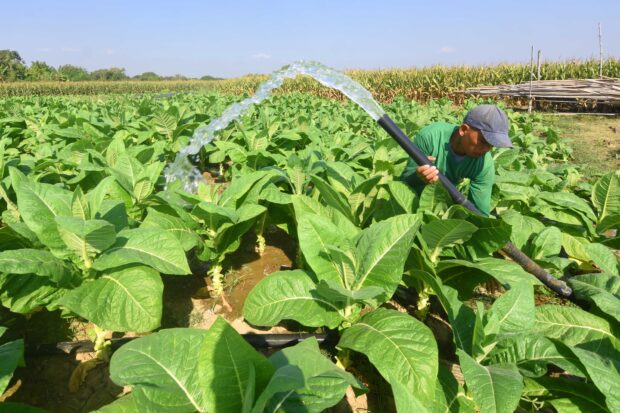
FARM WATCH Melvin Gagbo, 43, started planting tobacco as a teenager with his late father in Sta. Barbara, Pangasinan. He says he needs to water his burley tobacco plants regularly because the
soil in the family farm at Barangay Leet dries quickly due to the intense heat. —WILLIE LOMIBAO
TUMAUINI, ISABELA—As the midday temperature peaks on Friday, Sergio Areglado, a farmer from Barangay Liwanag here, proceeded to plant rice in his farm despite the imminent drought accompanying the El Niño weather phenomenon.
With the help of six farm hands, Areglado was hoping to earn by planting palay during the off-season cropping period even with the unfavorable weather conditions.
“Our farms are not irrigated during this time, but we have a nearby river to source water for our plants,” he said, noting that they plan to use water pumps for irrigation.
Areglado, 40, said another challenge would be the increasing cost of gasoline for farm equipment, as this would add to the overall production cost. He would typically spend between P80,000 and P100,000 per hectare for seeds, pesticides, fertilizers, labor and other provisions.
But Areglado said he was fortunate because he was able to sell his recently harvested palay for P25 to P27 per kilo.
“The current market for palay is still favorable. We just hope that we won’t face too many difficulties during this off-season planting period,” he shared.
Mark Mercado, another farmer from Gamu town, lamented that while their farmland in Mabini village is irrigated, the available water supply is insufficient.
“We’ll resort to using water pumps as our irrigation canals start to run dry,” he said.
Dam level
Some 80,000 hectares of farms in Isabela rely on Magat Dam for irrigation but water level in the reservoir continues to recede, raising concerns among the local farmers.
“There’s hardly any water left for our farms due to the impending drought,” Mercado said.
The National Irrigation Administration-Magat Dam Reservoir Division (NIA-Mariis) reported that the reservoir level had dropped to 181.92 meters above sea level on Friday, below the normal level of 191 masl and the spilling level of 193 masl.
Roldan Bermudez, head of the engineering and operations division of NIA-Mariis, said cloud seeding had been included in their contingency plan, especially in Isabela, Quirino and parts of Nueva Vizcaya and Ifugao.
Bermudez stressed that while the water supply in the dam is expected to last until the end of the dry cropping season, the drought is likely to impact crops during the wet cropping season, starting in May.
Damaged crops
In Pangasinan province, palay planted in 34.4 ha of farms at Barangay Evangelista in Tayug town had been destroyed, data from the Department of Agriculture (DA) in the Ilocos region showed.
Vida Cacal, information officer of DA Ilocos, said the crops, which were in the booting stage (period when the panicle grows), were beyond recovery.
At least 30 farmers cultivating the affected land have requested corn seeds as replacement for their lost palay.
Cacal said affected areas in Pangasinan were just a fraction of the over 68,539 ha of rice farms and 6,000 ha of corn farms identified as vulnerable to El Niño across the Ilocos region, primarily due to their reliance on rainwater.
Pangasinan bears the brunt of vulnerability to El Niño, with 35,300 ha identified as at risk.
The DA Ilocos has been allocated P1.6 billion for El Niño mitigation efforts, of which P870.3 million is readily available.
To mitigate El Niño’s impact, the agency has implemented various programs, including strengthening disaster response task forces, mapping drought-vulnerable areas, providing water pumps to farmers and distributing drought-resistant vegetable seeds, such as mongo and peanuts.
Local farmers were also encouraged to grow sweet potato and purple yam, which require less water.
In Ilocos Norte province, residents in the towns of Vintar, Marcos, Sarrat, Piddig, Bacarra and Dingras were asked to prepare for the impact of El Niño, according to the Ilocos Norte agriculture office.
A water scheduling scheme has been implemented by farmers in Sarrat to ensure the sufficiency of supply. Some wells in Sarrat and Pasuquin have also started drying up, residents said.
The provincial environment and natural resources office said measures were in place to control forest fires, particularly in the mountainous areas straddling Dingras, Solsona and Nueva Era.